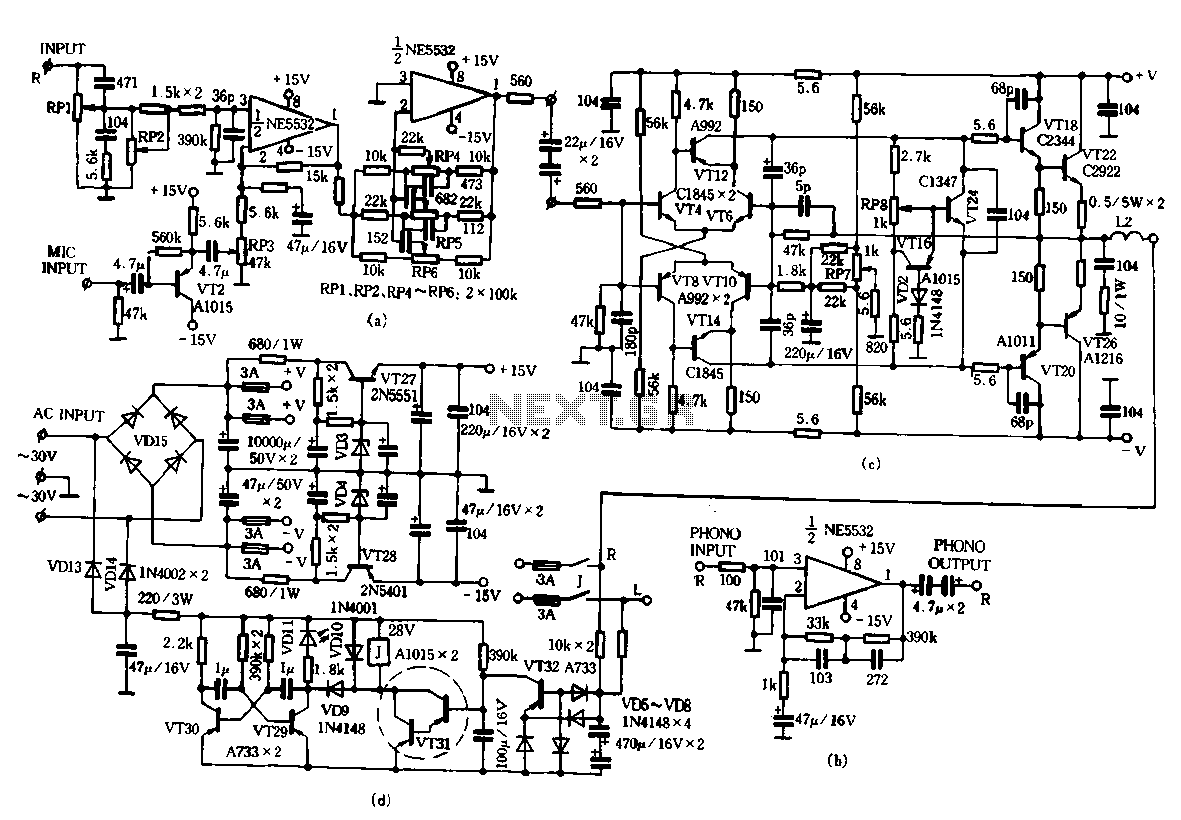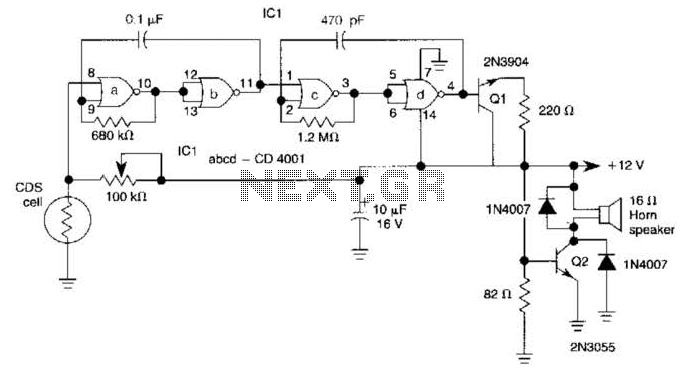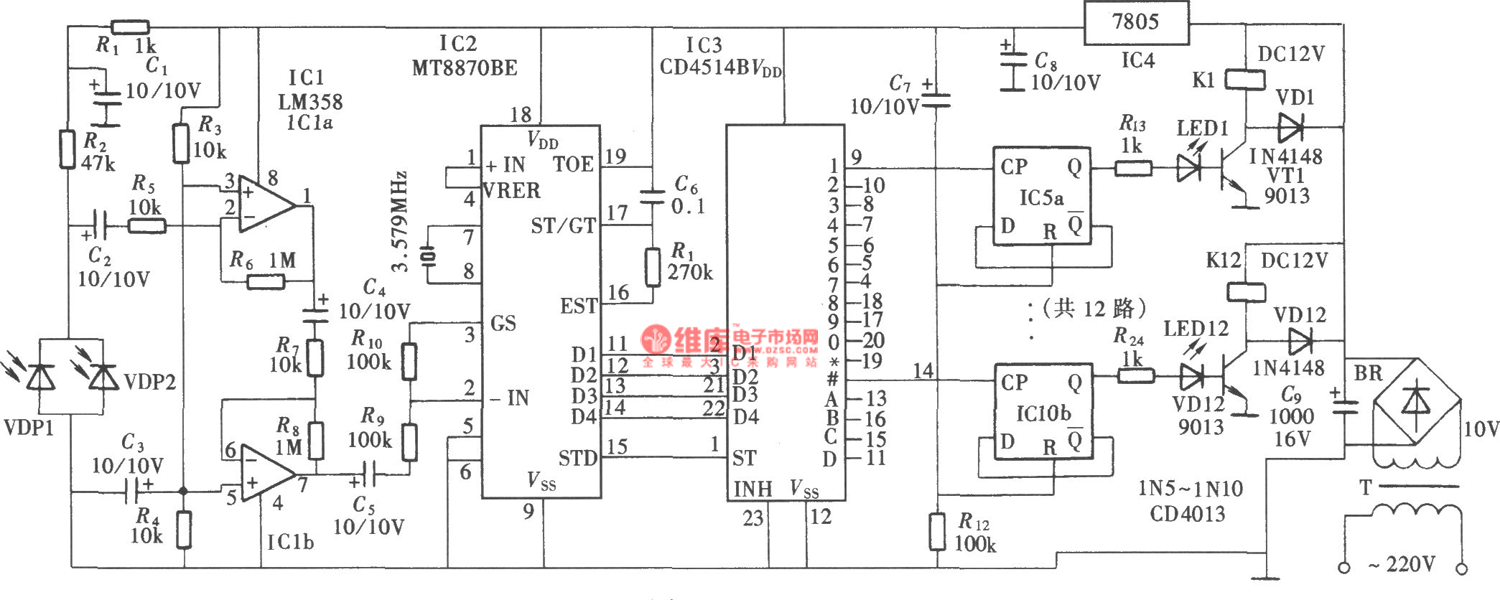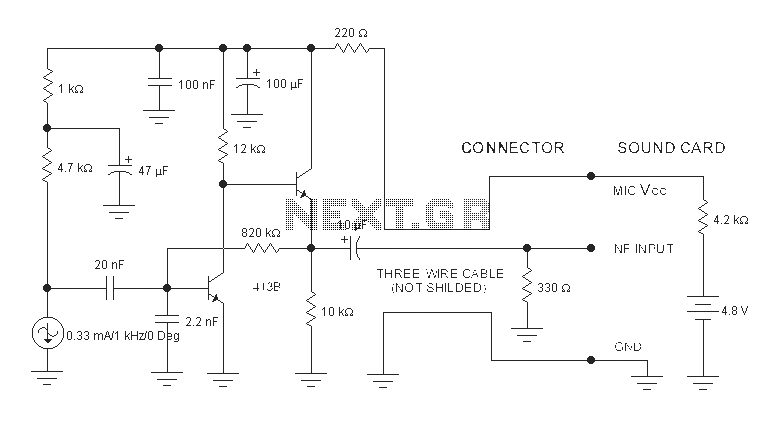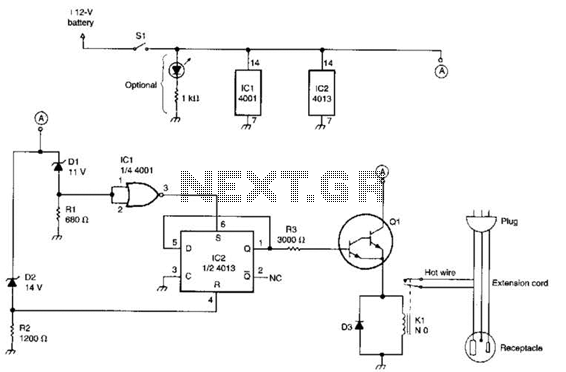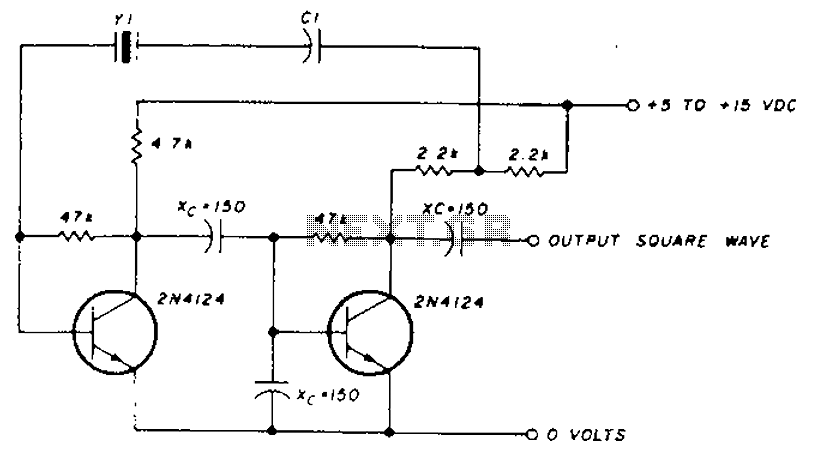
Automatic sprinkler control circuit
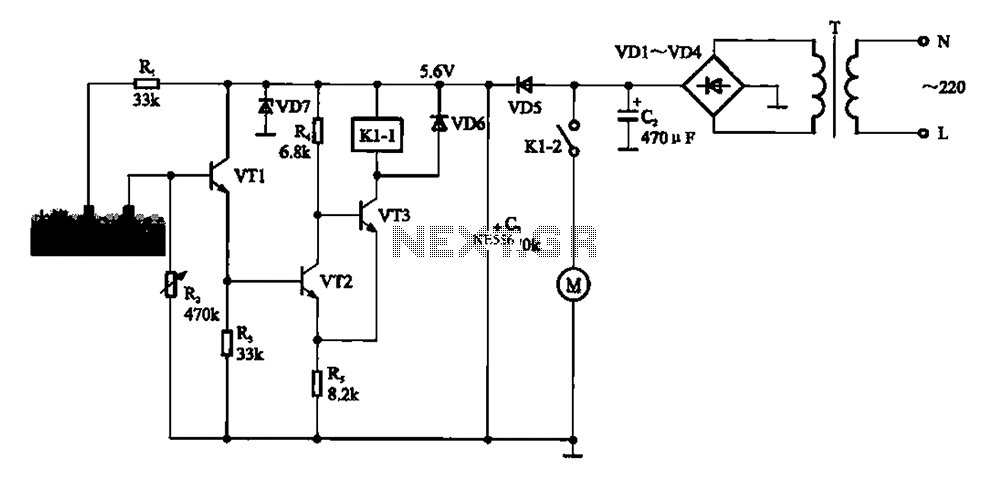
Automatic sprinkler control circuit. This circuit primarily consists of a humidity sensor, a detection signal amplifying circuit (including transistors VT1, VT2, and VT3), a power supply circuit (comprising a filter capacitor C2, a bridge conditioning circuit UR, and a transformer T), and a DC motor M. The humidity sensor detects moisture levels in the soil, while the DC motor M drives the operation of irrigation equipment. When the irrigation equipment operates for a certain duration, the soil moisture level reaches the required conditions for crop growth. At this point, the resistance value in the humidity sensor circuit decreases, causing VT1 to conduct and supply operating voltage to the base of VT2. This turns on VT2. When VT2 conducts, it shorts the base and emitter of VT3, causing the relay coil K1 to de-energize, which returns its normally open contact K1-2 to its default state, stopping the DC motor and halting the sprinkler irrigation equipment. Conversely, when the soil moisture decreases, the resistance value increases, lowering the base potential of VT1. This results in VT1 turning off, which in turn turns off VT2. The base of VT3 receives current, energizing relay coil K1 and closing normally open contact K1-2, thus powering the DC motor and restarting its operation.
The automatic sprinkler control circuit is designed to enhance the efficiency of irrigation systems by automating the process based on soil moisture conditions. The core component of this circuit is the humidity sensor, which provides real-time feedback on the moisture level in the soil. This sensor is typically a resistive type, where its resistance decreases with increasing moisture levels.
The detection signal amplifying circuit, composed of transistors VT1, VT2, and VT3, plays a crucial role in processing the signal from the humidity sensor. VT1 acts as the first stage of amplification; when the sensor detects adequate moisture, it allows for a sufficient voltage to turn on VT2. This transistor is responsible for controlling the state of VT3, which ultimately regulates the relay coil K1.
The power supply circuit ensures that the entire system receives stable voltage levels. It includes a transformer T that steps down the voltage to a suitable level for the circuit's operation. The bridge conditioning circuit UR and filter capacitor C2 work together to convert the AC voltage to a smooth DC voltage, providing the necessary power for the circuit components.
The relay K1 serves as a switch that controls the DC motor M, which is responsible for driving the irrigation equipment. When the circuit detects low moisture levels, the relay is energized, allowing current to flow to the DC motor, thus initiating the irrigation process. Conversely, when the soil moisture reaches adequate levels, the relay de-energizes, cutting off power to the motor and stopping irrigation.
This automatic control mechanism ensures that crops receive water only when necessary, conserving water and promoting healthy plant growth. The design is modular, allowing for easy integration of additional features such as timers or remote monitoring systems, which can further enhance the functionality of the irrigation system. Automatic sprinkler control circuit It shows automatic sprinkler control circuit. The circuit mainly by the humidity sensor, a detection signal amplifying circuit (transistor V T1,, RR2, VT3), the power supply circuit (filter capacitor C2, the bridge conditioning circuit UR, the transformer T), and the like of the DC motor M. In the circuit, a humidity sensor for detecting moisture in the soil, the DC motor M for driving irrigation equipment operation.
After working for some time irrigation equipment, soil moisture for crop growth conditions to achieve at this time embodied in the humidity sensor circuit resistance value is small, this time VT1 conduction, and to provide operating voltage VT2 base. VT2 are turned on. vr2 after conducting direct VT3 base and emitter short-circuited, VT3 end, so that the relay coil Kl-l de-energized, and drive its normally open contact Kl-2 recovery normally open state, the DC motor power to stop jobs.
Sprinkler irrigation equipment stops. When soil moisture dries, moisture transfer resistance between Bo value increases, resulting VT1 base potential is low, this time off VT1, VT2 off, VT3 base provided by the current conduction, the relay coil Kl -l was electric pull and drive normally open contact Kl 2 is closed, the DC motor power and start working.
The automatic sprinkler control circuit is designed to enhance the efficiency of irrigation systems by automating the process based on soil moisture conditions. The core component of this circuit is the humidity sensor, which provides real-time feedback on the moisture level in the soil. This sensor is typically a resistive type, where its resistance decreases with increasing moisture levels.
The detection signal amplifying circuit, composed of transistors VT1, VT2, and VT3, plays a crucial role in processing the signal from the humidity sensor. VT1 acts as the first stage of amplification; when the sensor detects adequate moisture, it allows for a sufficient voltage to turn on VT2. This transistor is responsible for controlling the state of VT3, which ultimately regulates the relay coil K1.
The power supply circuit ensures that the entire system receives stable voltage levels. It includes a transformer T that steps down the voltage to a suitable level for the circuit's operation. The bridge conditioning circuit UR and filter capacitor C2 work together to convert the AC voltage to a smooth DC voltage, providing the necessary power for the circuit components.
The relay K1 serves as a switch that controls the DC motor M, which is responsible for driving the irrigation equipment. When the circuit detects low moisture levels, the relay is energized, allowing current to flow to the DC motor, thus initiating the irrigation process. Conversely, when the soil moisture reaches adequate levels, the relay de-energizes, cutting off power to the motor and stopping irrigation.
This automatic control mechanism ensures that crops receive water only when necessary, conserving water and promoting healthy plant growth. The design is modular, allowing for easy integration of additional features such as timers or remote monitoring systems, which can further enhance the functionality of the irrigation system. Automatic sprinkler control circuit It shows automatic sprinkler control circuit. The circuit mainly by the humidity sensor, a detection signal amplifying circuit (transistor V T1,, RR2, VT3), the power supply circuit (filter capacitor C2, the bridge conditioning circuit UR, the transformer T), and the like of the DC motor M. In the circuit, a humidity sensor for detecting moisture in the soil, the DC motor M for driving irrigation equipment operation.
After working for some time irrigation equipment, soil moisture for crop growth conditions to achieve at this time embodied in the humidity sensor circuit resistance value is small, this time VT1 conduction, and to provide operating voltage VT2 base. VT2 are turned on. vr2 after conducting direct VT3 base and emitter short-circuited, VT3 end, so that the relay coil Kl-l de-energized, and drive its normally open contact Kl-2 recovery normally open state, the DC motor power to stop jobs.
Sprinkler irrigation equipment stops. When soil moisture dries, moisture transfer resistance between Bo value increases, resulting VT1 base potential is low, this time off VT1, VT2 off, VT3 base provided by the current conduction, the relay coil Kl -l was electric pull and drive normally open contact Kl 2 is closed, the DC motor power and start working.
